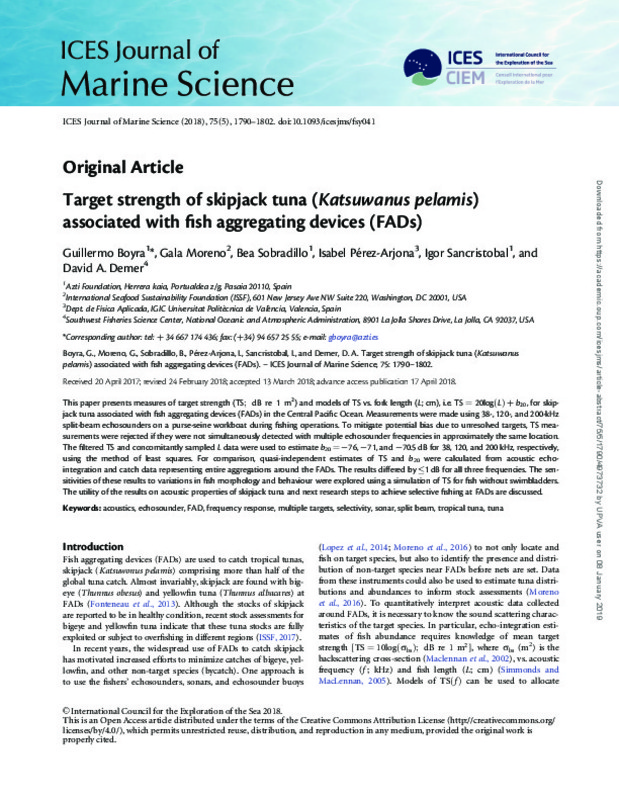JavaScript is disabled for your browser. Some features of this site may not work without it.
Buscar en RiuNet
Listar
Mi cuenta
Estadísticas
Ayuda RiuNet
Admin. UPV
Target strength of skipjack tuna (Katsuwanus pelamis) associated with fish aggregating devices (FADs)
Mostrar el registro sencillo del ítem
Ficheros en el ítem
| dc.contributor.author | Boyra, G .
|
es_ES |
| dc.contributor.author | Moreno, G.
|
es_ES |
| dc.contributor.author | Sobradillo, B.
|
es_ES |
| dc.contributor.author | Pérez Arjona, Isabel
|
es_ES |
| dc.contributor.author | Sancristóbal, I.
|
es_ES |
| dc.contributor.author | Demer, David
|
es_ES |
| dc.date.accessioned | 2019-02-09T21:03:47Z | |
| dc.date.available | 2019-02-09T21:03:47Z | |
| dc.date.issued | 2018 | es_ES |
| dc.identifier.issn | 1054-3139 | es_ES |
| dc.identifier.uri | http://hdl.handle.net/10251/116595 | |
| dc.description.abstract | [EN] This paper presents measures of target strength (TS; dB re 1 m(2)) and models of TS vs. fork length (L; cm), i.e. TS = 20log(L) + b(20), for skip-jack tuna associated with fish aggregating devices (FADs) in the Central Pacific Ocean. Measurements were made using 38-, 120-, and 200-kHz split-beam echosounders on a purse-seine workboat during fishing operations. To mitigate potential bias due to unresolved targets, TS measurements were rejected if they were not simultaneously detected with multiple echosounder frequencies in approximately the same location. The filtered TS and concomitantly sampled L data were used to estimate b(20) = -76, -71, and -70.5 dB for 38, 120, and 200 kHz, respectively, using the method of least squares. For comparison, quasi-independent estimates of TS and b(20) were calculated from acoustic echo-integration and catch data representing entire aggregations around the FADs. The results differed by <= 1 dB for all three frequencies. The sensitivities of these results to variations in fish morphology and behaviour were explored using a simulation of TS for fish without swimbladders. The utility of the results on acoustic properties of skipjack tuna and next research steps to achieve selective fishing at FADs are discussed. | es_ES |
| dc.description.sponsorship | We thank the following organizations and people for their support of this work: the governments of Kiribati, Tuvalu, and Tokelau which permitted this research in their EEZs; Albacora for allowing this work aboard F/V ALBATUN TRES; Fishing Master Euken Mujika; the captain and crew; the scientists and divers J. Filmalter and F. Forget are thanked for invaluable insight about fish behaviour, vertical stratification and non-target species composition at FADs; Hector Pena for providing instruction on the sonar setup and analysis; Yolanda Lacalle for the illustration in Figure 2; and Andres Uriarte for advice concerning transmission of statistical errors. The research reported in the present document was funded by the International Seafood Sustainability Foundation (ISSF) and conducted independently by the authors. The report and its results, professional opinions and conclusions are solely the work of the authors. This paper is contribution 843 from AZTI (Marine or Food Research). | |
| dc.language | Inglés | es_ES |
| dc.publisher | Oxford University Press | es_ES |
| dc.relation.ispartof | ICES Journal of Marine Science | es_ES |
| dc.rights | Reconocimiento (by) | es_ES |
| dc.subject | Acoustics | es_ES |
| dc.subject | Echosounder | es_ES |
| dc.subject | FAD | es_ES |
| dc.subject | Frequency response | es_ES |
| dc.subject | Multiple targets | es_ES |
| dc.subject | Selectivity | es_ES |
| dc.subject | Sonar | es_ES |
| dc.subject | Split beam | es_ES |
| dc.subject | Tropical tuna | es_ES |
| dc.subject | Tuna | es_ES |
| dc.subject.classification | FISICA APLICADA | es_ES |
| dc.title | Target strength of skipjack tuna (Katsuwanus pelamis) associated with fish aggregating devices (FADs) | es_ES |
| dc.type | Artículo | es_ES |
| dc.identifier.doi | 10.1093/icesjms/fsy041 | es_ES |
| dc.rights.accessRights | Abierto | es_ES |
| dc.contributor.affiliation | Universitat Politècnica de València. Departamento de Física Aplicada - Departament de Física Aplicada | es_ES |
| dc.description.bibliographicCitation | Boyra, G..; Moreno, G.; Sobradillo, B.; Pérez Arjona, I.; Sancristóbal, I.; Demer, D. (2018). Target strength of skipjack tuna (Katsuwanus pelamis) associated with fish aggregating devices (FADs). ICES Journal of Marine Science. 75(5):1790-1802. https://doi.org/10.1093/icesjms/fsy041 | es_ES |
| dc.description.accrualMethod | S | es_ES |
| dc.relation.publisherversion | http://doi.org/10.1093/icesjms/fsy041 | es_ES |
| dc.description.upvformatpinicio | 1790 | es_ES |
| dc.description.upvformatpfin | 1802 | es_ES |
| dc.type.version | info:eu-repo/semantics/publishedVersion | es_ES |
| dc.description.volume | 75 | es_ES |
| dc.description.issue | 5 | es_ES |
| dc.relation.pasarela | S\366579 | es_ES |
| dc.contributor.funder | International Seafood Sustainability Foundation | |
| dc.contributor.funder | Government of Kiribati | |
| dc.contributor.funder | Governement of Tuvalu | |
| dc.contributor.funder | Government of Tokelau |








